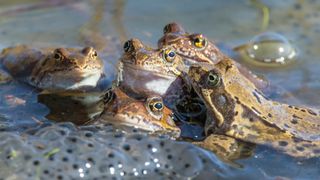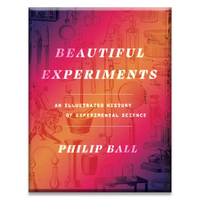'[He] attempted to study fertilization in frogs by fitting the males with tiny trousers': The science of sperm in the 1700s
Spallanzani has been described as having a "lust for knowledge": a passion that sometimes seemed to exceed propriety, as when he was said to have begun expounding enthusiastically to a group of dignitaries about the mating of frogs.

In the excerpt below taken from "Beautiful Experiments: An Illustrated History of Experimental Science" (The University of Chicago Press, 2023), Philip Ball dives into the 17th and 18th century experiments that sought to figure out the answer to a fundamental question: What induces eggs to develop? From microscopic observations of spermatozoa to special little sperm-catching trousers for frogs, Ball reveals how we came to understand fertilization.
It was always clear that for the reproduction of humans and other mammals, both the male and the female have a role. But what role, exactly? Aristotle proposed that both sexes contribute a kind of generative principle called "sperma," which combine to produce the rational human soul in the growing fetus in a process he called "epigenesis."
Reflecting the chauvinistic attitude that shaped most theories of procreation until modern times, the male principle was considered the active element, which grew like a seed in the passive receptacle supplied by the woman. In one of the earliest recorded examples of experimental science, Aristotle carefully opened and examined chick eggs at different stages from fertilization to birth in order to watch the development of the fetuses.
In the 17th century, the English physician William Harvey, while largely endorsing the Aristotelian position, placed more emphasis on the role of the egg from the female. Ex ovo omnia, as he put it in 1651: everything comes from an egg, a position called ovism. But Antonie van Leeuwenhoek's microscopic observations of spermatozoa in the 1670s led to the notion that the developing body is somehow inherent already in the head of the worm-like entities seen in sperm (spermatozoa literally means "sperm animals").
The concept was strikingly illustrated in 1694 by the Dutch microscopist Nicolaas Hartsoeker, who drew a sperm with a fetal homunculus packed into the head, complete with tiny limbs. In this preformationist view the body was already fully formed, whereas in the [epigenesis] view it developed from an unstructured seed.

It was all largely conjecture, because of the difficulties of making observations and experiments on human conception. Then, as still today, much of what was known about embryology relied on studies of other animals. In the mid-18th century, an Italian physiologist and priest named Lazzaro Spallanzani set out to investigate the precise role of male semen by studying reproduction in frogs. Spallanzani has been described as having a "lust for knowledge:" a passion that sometimes seemed to exceed propriety, as when he was said to have begun expounding enthusiastically to a group of dignitaries about the mating of frogs he had noticed in a body of water during travels in Constantinople.
Related: These female frogs fake their own deaths to get out of sex
That was surely a rather indecent topic of discourse for a man who had been ordained in the Church. Frogs do not actually copulate, though. Rather, the female lays her eggs, onto which the male then deposits his semen.

Although Spallanzani shared Harvey's epigenetic view of development from a fertilized egg, he suspected that the spermatozoa play no role, but are instead a kind of parasite. It is the thinner, liquid component of the semen, Spallanzani thought, that provides the generative principle.
To test that idea, Spallanzani needed to collect frog sperm and separate the microscopic "worms" from the seminal fluid. He borrowed an idea from the French scientist René Antoine de Réaumur, who in 1736 attempted to study fertilization in frogs by fitting the males with tiny trousers made from taffeta and pig's bladder, so that he might collect and study their sperm. He had little success with this, however, because the frogs wriggled out of their garments. But Spallanzani's prophylactic frog trousers were more successful. By applying some of the semen obtained in this way to frog eggs, he conducted the first known example of artificial insemination.
Spallanzani never managed to elucidate the connection between spermatozoa and fertilization, however. After filtering the collected sperm to separate the liquid from the thicker residue containing spermatozoa, he found that only the latter could cause fertilization — and yet, to the bemusement of many historians of science, he still believed that the fertilizing capacity resided with the liquid.
In one set of experiments he kept toad sperm and eggs on pocket-watch glasses just a few millimeters apart to see if the eggs might be fertilized by some intangible "aura" emanating from the sperm (they were not, of course). Some think Spallanzani was too much in thrall to a kind of preformationist ovism, believing that the embryo's form was already dormant in the egg and needed only the barest stimulus from semen to start it developing.
At any rate, he exemplifies how, even if a scientist does the right kind of experiment, there's no guarantee that they will draw the correct conclusion from it. Spallanzani later extended his investigations to dogs, collecting semen from a male and injecting it with a syringe into the uterus of a bitch. Seeing the resulting pregnancy and the birth of pups was, he wrote, "one of the greatest joys of my life." He also experimented with preserving sperm using ice to see if it retained a capacity to fertilize.
Reprinted with permission from Beautiful Experiments: An Illustrated History of Experimental Science by Philip Ball, published by The University of Chicago Press. © 2023 by Quarto Publishing plc. All rights reserved.
Beautiful Experiments: An Illustrated History of Experimental Science - $25.82 on Amazon
Philip Ball's illustrated history of experimental science is a celebration of the ingenuity that scientists and natural philosophers have used throughout the ages to study — and to change — the world.
If you enjoyed this extract you can read another extract from the book: How Isaac Newton's experiments revealed the mystery of light
Live Science newsletter
Stay up to date on the latest science news by signing up for our Essentials newsletter.

Philip Ball is a freelance writer and broadcaster, and was an editor at Nature for more than twenty years. He writes regularly in the scientific and popular media and has written many books on the interactions of the sciences, the arts, and wider culture, including "H2O: A Biography of Water" and "The Music Instinct." His book "Critical Mass" won the 2005 Aventis Prize for Science Books. Ball is also the 2022 recipient of the Royal Society’s Wilkins-Bernal-Medawar Medal for contributions to the history, philosophy, or social roles of science. He trained as a chemist at the University of Oxford and as a physicist at the University of Bristol, and he was an editor at Nature for more than twenty years.
Most Popular

By Ben Turner


By Harry Baker

By Tom Metcalfe

By Emily Cooke
